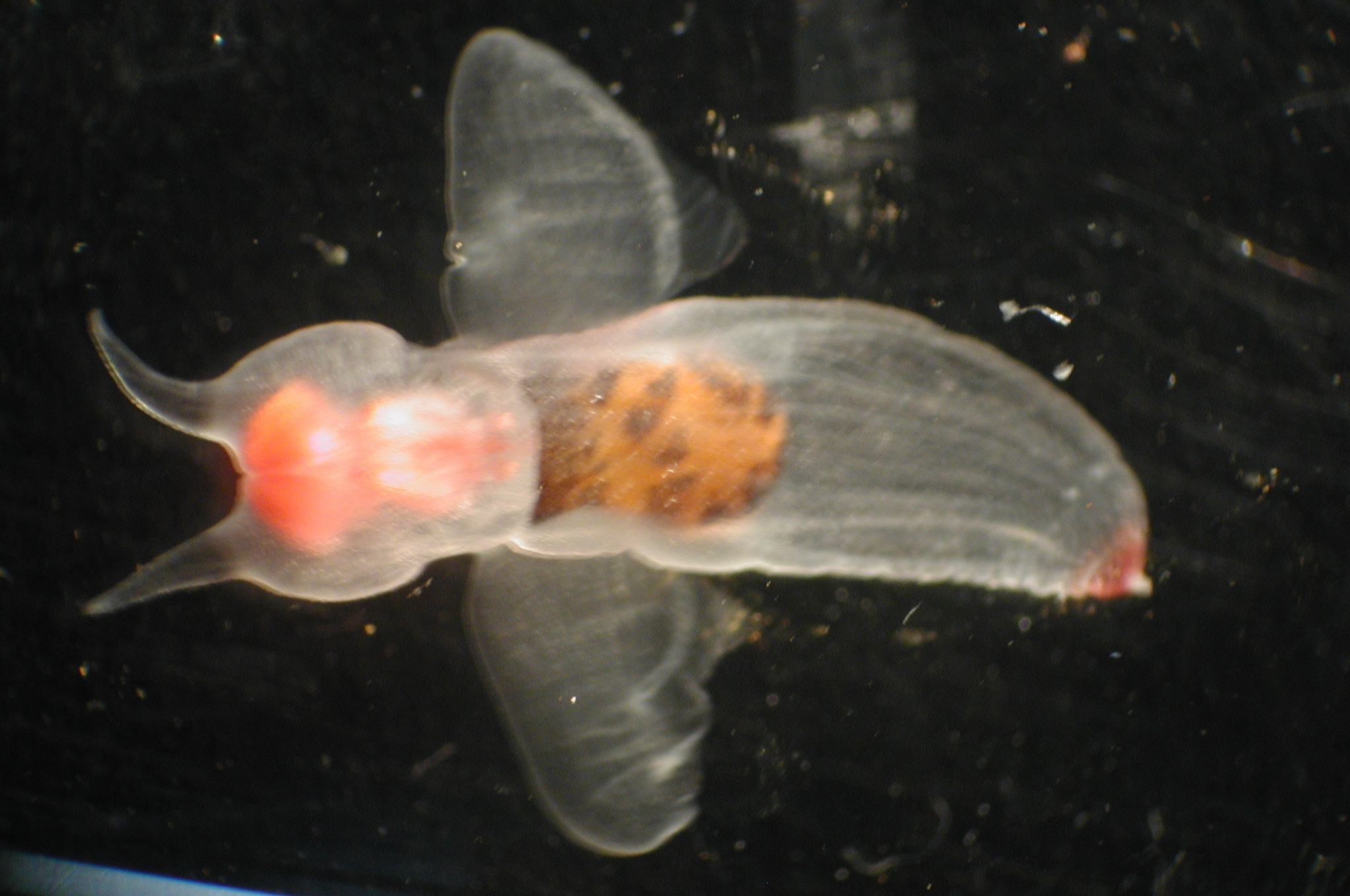- Heterobranchia
Taxobox
name = Heterobranchia

image_caption = The sea butterfly or pteropod gastropod, "Clione limacina "
regnum =Animal ia
phylum =Mollusca
classis =Gastropoda
subclassis =Orthogastropoda
superordo = Heterobranchia
subdivision_ranks = Orders
subdivision =Heterostropha Opisthobranchia Pulmonata Heterobranchia, the "heterobranchs", (meaning "different-gilled snails"), is a
taxonomic superorder of seasnail s, marinegastropod mollusk s.(Note: Gastropod
taxonomy has been in flux for many years, and this is especially true currently, because of new research inmolecular phylogeny . Because of all this on-going change, different reliable sources can yield very different classifications. This is especially true within groups which are poorly understood in general.)This superorder contains a diverse and interesting group of families. The similarity in the structure of the gills within this group makes the various families eligible for membership, despite all the other differences they show.
The families included in this recently established superorder of mollusks [cite journal | quotes=no | author = Haszprunar G. |title = The Heterobranchia ― a new concept of the phylogeny of the higher Gastropoda|year = 1985| journal = Zeitschrift für zoologische Systematik und Evolutionsforschung|volume = 23| issue = 1 | pages = 15–37 ISSN 0044-3808] have historically been placed in many different parts of the taxonomic class of gastropods. Earlier authors (as J.E. Gray, 1840) placed the Heterobranchia as a borderline category intermediate between the
Opisthobranchia &Pulmonata , and all the other gastropods.The (sometimes recognized) order
Heterostropha within the Heterobranchia, which includes such families as "Architectonicidae ", the sundial or staircase snails, is primarily characterized by a shell which has a heterostrophicprotoconch , in other words the apical whorls are coiled in the opposite plane to the adult whorls. The classification of this group has been revised by Ponder & Warén (1988) [cite journal | quotes=no | author = Ponder, W. F. & Warén, A. |title = Classification of the Caenogastropoda and Heterostropha- A list of family-group names and higher taxa|year = 1988| journal = Malacological review supplement |volume = 4| issue =| pages = 288–317] .(In contrast to the heterobranchs, the bodies of the Opisthobranchia have undergone detorsion (unwinding). They have essentially evolved back to the bilateral symmetry of their ancestors. The mantle cavity of the Pulmonata has modified into an air-breathing organ. They are also characterized by detorsion and a symmetrically-arranged nervous system. The pulmonates usually lack an operculum and are
hermaphroditic . The order Pulmonata contains most land snails and slugs, many freshwater snails, and a small number of fully marine species.)Taxonomy of the Heterobranchia
Superorder Heterobranchia J.E. Gray, 1840
*OrderHeterostropha P. Fischer, 1885 (sometimes Allogastropoda Haszprunar, 1985) (paraphyletic)
*OrderOpisthobranchia Milne-Edwards, 1848 (paraphyletic)
**SuborderCephalaspidea P. Fischer, 1883 (headshield slugs)
**SuborderSacoglossa Von Ihering, 1876 (sap-suckling slugs)
**SuborderAnaspidea P. Fischer, 1883 (sea hares)
**SuborderNotaspidea P. Fischer, 1883 (sidegill slugs)
**SuborderThecosomata de Blainville, 1824 (sea butterflies)
***InfraorderEuthecosomata
***InfraorderPseudothecosomata
**SuborderGymnosomata de Blainville, 1824 (sea angels)
**SuborderNudibranchia de Blainville, 1814 (nudibranchs, true sea slugs))
***InfraorderAnthobranchia Férussac, 1819
***InfraorderCladobranchia Willan & Morton, 1984
*OrderPulmonata Cuvier in Blainville, 1814 (pulmonates)
**SuborderSystellommatophora Pilsbry, 1948
**SuborderBasommatophora Keferstein in Bronn, 1864 (freshwater pulmonates, pond snails)
**SuborderEupulmonata Haszprunar & Huber, 1990
***InfraorderActeophila (Dall, 1885 (formerly Archaeopulmonata)
***InfraorderTrimusculiformes Minichev & Starobogatov, 1975
***InfraorderStylommatophora A. Schmidt, 1856 (land snails)
****SubinfraorderOrthurethra
****SubinfraorderSigmurethra Clade Heterobranchia
*Grade Heterostropha
*Clade Euthyneura
**Grade Opisthobranchia
**Clade PulmonataReferences
Wikimedia Foundation. 2010.
